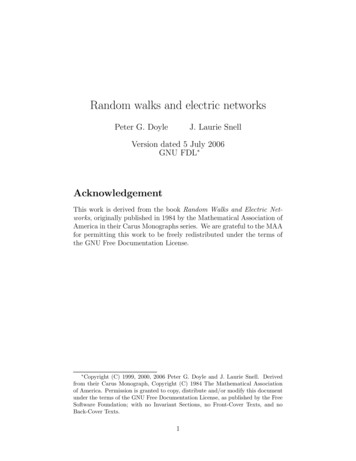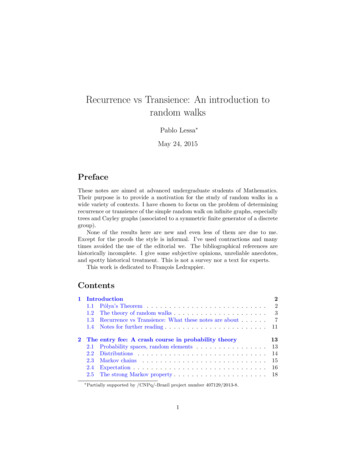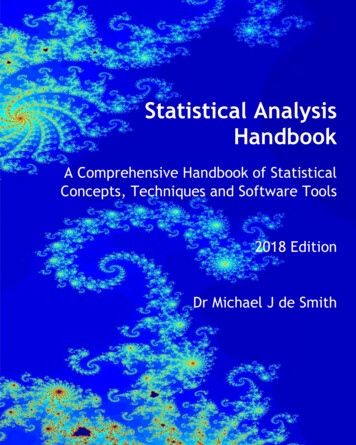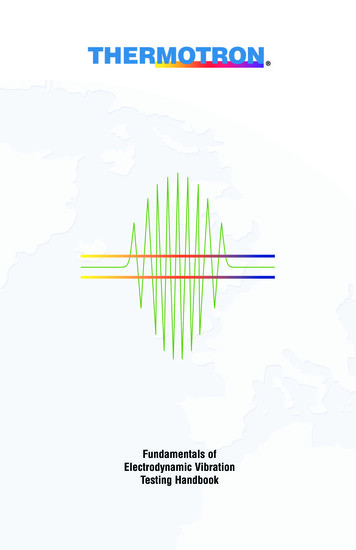
Transcription
Random walks and electric networksPeter G. DoyleJ. Laurie SnellVersion dated 5 July 2006GNU FDL AcknowledgementThis work is derived from the book Random Walks and Electric Networks, originally published in 1984 by the Mathematical Association ofAmerica in their Carus Monographs series. We are grateful to the MAAfor permitting this work to be freely redistributed under the terms ofthe GNU Free Documentation License.Copyright (C) 1999, 2000, 2006 Peter G. Doyle and J. Laurie Snell. Derivedfrom their Carus Monograph, Copyright (C) 1984 The Mathematical Associationof America. Permission is granted to copy, distribute and/or modify this documentunder the terms of the GNU Free Documentation License, as published by the FreeSoftware Foundation; with no Invariant Sections, no Front-Cover Texts, and noBack-Cover Texts. 1
PrefaceProbability theory, like much of mathematics, is indebted to physics asa source of problems and intuition for solving these problems. Unfortunately, the level of abstraction of current mathematics often makes itdifficult for anyone but an expert to appreciate this fact. In this workwe will look at the interplay of physics and mathematics in terms of anexample where the mathematics involved is at the college level. Theexample is the relation between elementary electric network theory andrandom walks.Central to the work will be Polya’s beautiful theorem that a randomwalker on an infinite street network in d-dimensional space is bound toreturn to the starting point when d 2, but has a positive probabilityof escaping to infinity without returning to the starting point whend 3. Our goal will be to interpret this theorem as a statement aboutelectric networks, and then to prove the theorem using techniques fromclassical electrical theory. The techniques referred to go back to LordRayleigh, who introduced them in connection with an investigation ofmusical instruments. The analog of Polya’s theorem in this connectionis that wind instruments are possible in our three-dimensional world,but are not possible in Flatland (Abbott [1]).The connection between random walks and electric networks hasbeen recognized for some time (see Kakutani [12], Kemeny, Snell, andKnapp [14], and Kelly [13]). As for Rayleigh’s method, the authorsfirst learned it from Peter’s father Bill Doyle, who used it to explain amysterious comment in Feller ([5], p. 425, Problem 14). This commentsuggested that a random walk in two dimensions remains recurrentwhen some of the streets are blocked, and while this is ticklish to proveprobabilistically, it is an easy consequence of Rayleigh’s method. Thefirst person to apply Rayleigh’s method to random walks seems to havebeen Nash-Williams [24]. Earlier, Royden [30] had applied Rayleigh’smethod to an equivalent problem. However, the true importance ofRayleigh’s method for probability theory is only now becoming appreciated. See, for example, Griffeath and Liggett [9], Lyons [20], andKesten [16].Here’s the plan of the work: In Section 1 we will restrict ourselvesto the study of random walks on finite networks. Here we will establishthe connection between the electrical concepts of current and voltageand corresponding descriptive quantities of random walks regarded asfinite state Markov chains. In Section 2 we will consider random walks2
on infinite networks. Polya’s theorem will be proved using Rayleigh’smethod, and the proof will be compared with the classical proof usingprobabilistic methods. We will then discuss walks on more generalinfinite graphs, and use Rayleigh’s method to derive certain extensionsof Polya’s theorem. Certain of the results in Section 2 were obtainedby Peter Doyle in work on his Ph.D. thesis.To read this work, you should have a knowledge of the basic conceptsof probability theory as well as a little electric network theory andlinear algebra. An elementary introduction to finite Markov chains aspresented by Kemeny, Snell, and Thompson [15] would be helpful.The work of Snell was carried out while enjoying the hospitality ofChurchill College and the Cambridge Statistical Laboratory supportedby an NSF Faculty Development Fellowship. He thanks ProfessorsKendall and Whittle for making this such an enjoyable and rewardingvisit. Peter Doyle thanks his father for teaching him how to think like aphysicist. We both thank Peter Ney for assigning the problem in Fellerthat started all this, David Griffeath for suggesting the example to beused in our first proof that 3-dimensional random walk is recurrent(Section 2.2.9), and Reese Prosser for keeping us going by his friendlyand helpful hectoring. Special thanks are due Marie Slack, our secretary extraordinaire, for typing the original and the excessive number ofrevisions one is led to by computer formatting.11.11.1.1Random walks on finite networksRandom walks in one dimensionA random walk along Madison AvenueA random walk, or drunkard’s walk, was one of the first chance processes studied in probability; this chance process continues to play animportant role in probability theory and its applications. An exampleof a random walk may be described as follows:A man walks along a 5-block stretch of Madison Avenue. He startsat corner x and, with probability 1/2, walks one block to the right and,with probability 1/2, walks one block to the left; when he comes tothe next corner he again randomly chooses his direction along MadisonAvenue. He continues until he reaches corner 5, which is home, orcorner 0, which is a bar. If he reaches either home or the bar, he staysthere. (See Figure 1.)3
Figure 1: The problem we pose is to find the probability p(x) that the man,starting at corner x, will reach home before reaching the bar. In lookingat this problem, we will not be so much concerned with the particularform of the solution, which turns out to be p(x) x/5, as with itsgeneral properties, which we will eventually describe by saying “p(x) isthe unique solution to a certain Dirichlet problem.”1.1.2The same problem as a penny matching gameIn another form, the problem is posed in terms of the following game:Peter and Paul match pennies; they have a total of 5 pennies; on eachmatch, Peter wins one penny from Paul with probability 1/2 and losesone with probability 1/2; they play until Peter’s fortune reaches 0 (heis ruined) or reaches 5 (he wins all Paul’s money). Now p(x) is theprobability that Peter wins if he starts with x pennies.1.1.3The probability of winning: basic propertiesConsider a random walk on the integers 0, 1, 2, . . . , N . Let p(x) be theprobability, starting at x, of reaching N before 0. We regard p(x) asa function defined on the points x 0, 1, 2, . . . , N . The function p(x)has the following properties:(a) p(0) 0.(b) p(N ) 1.(c) p(x) 21 p(x 1) 21 p(x 1) for x 1, 2, . . . , N 1.Properties (a) and (b) follow from our convention that 0 and N aretraps; if the walker reaches one of these positions, he stops there; inthe game interpretation, the game ends when one player has all of the4
pennies. Property (c) states that, for an interior point, the probabilityp(x) of reaching home from x is the average of the probabilities p(x 1)and p(x 1) of reaching home from the points that the walker maygo to from x. We can derive (c) from the following basic fact aboutprobability:Basic Fact. Let E be any event, and F and G be events such thatone and only one of the events F or G will occur. ThenP(E) P(F ) · P(E given F ) P(G) · P(E given G).In this case, let E be the event “the walker ends at the bar”, Fthe event “the first step is to the left”, and G the event “the firststep is to the right”. Then, if the walker starts at x, P(E) p(x),P(F ) P(G) 21 , P(E given F ) p(x 1), P(E given G) p(x 1),and (c) follows.1.1.4An electric network problem: the same problem?Let’s consider a second apparently very different problem. We connectequal resistors in series and put a unit voltage across the ends as inFigure 2.Figure 2: Voltages v(x) will be established at the points x 0, 1, 2, 3, 4, 5. Wehave grounded the point x 0 so that v(0) 0. We ask for the voltagev(x) at the points x between the resistors. If we have N resistors, wemake v(0) 0 and v(N ) 1, so v(x) satisfies properties (a) and (b) ofSection 1.1.3. We now show that v(x) also satisfies (c).By Kirchhoff’s Laws, the current flowing into x must be equal tothe current flowing out. By Ohm’s Law, if points x and y are connected5
by a resistance of magnitude R, then the current ixy that flows from xto y is equal tov(x) v(y).ixy RThus for x 1, 2, . . . , N 1,v(x 1) v(x) v(x 1) v(x) 0.RRMultiplying through by R and solving for v(x) givesv(x) v(x 1) v(x 1)2for x 1, 2, . . . , N 1. Therefore, v(x) also satisfies property (c).We have seen that p(x) and v(x) both satisfy properties (a), (b),and (c) of Section 1.1.3. This raises the question: are p(x) and v(x)equal? For this simple example, we can easily find v(x) using Ohm’sLaw, find p(x) using elementary probability, and see that they are thesame. However, we want to illustrate a principle that will work for verygeneral circuits. So instead we shall prove that these two functions arethe same by showing that there is only one function that satisfies theseproperties, and we shall prove this by a method that will apply to moregeneral situations than points connected together in a straight line.Exercise 1.1.1 Referring to the random walk along Madison Avenue,let X p(1), Y p(2), Z p(3), and W p(4). Show that properties(a), (b), and (c) of Section 1.1.3 determine a set of four linear equationswith variables X, Y , Z and W . Show that these equations have aunique solution. What does this say about p(x) and v(x) for this specialcase?Exercise 1.1.2 Assume that our walker has a tendency to drift in onedirection: more specifically, assume that each step is to the right withprobability p or to the left with probability q 1 p. Show thatproperties (a), (b), and (c) of Section 1.1.3 should be replaced by(a) p(0) 0.(b) p(N ) 1.(c) p(x) q · p(x 1) p · p(x 1).6
Exercise 1.1.3 In our electric network problem, assume that the resistors are not necessarily equal. Let Rx be the resistance between xand x 1. Show thatv(x) 1Rx 11Rx 1 1Rxv(x 1) 1Rx1Rx 1 1Rxv(x 1).How should the resistors be chosen to correspond to the random walkof Exercise 1.1.2?1.1.5Harmonic functions in one dimension; the UniquenessPrincipleLet S be the set of points S {0, 1, 2, . . . , N }. We call the points ofthe set D {1, 2, . . . , N 1} the interior points of S and those ofB {0, N } the boundary points of S. A function f (x) defined on S isharmonic if, at points of D, it satisfies the averaging propertyf (x) f (x 1) f (x 1).2As we have seen, p(x) and v(x) are harmonic functions on S havingthe same values on the boundary: p(0) v(0) 0; p(N ) v(N ) 1. Thus both p(x) and v(x) solve the problem of finding a harmonicfunction having these boundary values. Now the problem of findinga harmonic function given its boundary values is called the Dirichletproblem, and the Uniqueness Principle for the Dirichlet problem assertsthat there cannot be two different harmonic functions having the sameboundary values. In particular, it follows that p(x) and v(x) are reallythe same function, and this is what we have been hoping to show. Thusthe fact that p(x) v(x) is an aspect of a general fact about harmonicfunctions.We will approach the Uniqueness Principle by way of the Maximum Principle for harmonic functions, which bears the same relationto the Uniqueness Principle as Rolle’s Theorem does to the Mean ValueTheorem of Calculus.Maximum Principle . A harmonic function f (x) defined on Stakes on its maximum value M and its minimum value m on the boundary.Proof. Let M be the largest value of f . Then if f (x) M for xin D, the same must be true for f (x 1) and f (x 1) since f (x) isthe average of these two values. If x 1 is still an interior point, the7
same argument implies that f (x 2) M ; continuing in this way, weeventually conclude that f (0) M . That same argument works forthe minimum value m. Uniqueness Principle. If f (x) and g(x) are harmonic functionson S such that f (x) g(x) on B, then f (x) g(x) for all x.Proof. Let h(x) f (x) g(x). Then if x is any interior point,h(x 1) h(x 1)f (x 1) f (x 1) g(x 1) g(x 1) ,222and h is harmonic. But h(x) 0 for x in B, and hence, by the Maximum Principle, the maximum and mininium values of h are 0. Thush(x) 0 for all x, and f (x) g(x) for all x. Thus we finally prove that p(x) v(x); but what does v(x) equal?The Uniqueness Principle shows us a way to find a concrete answer:just guess. For if we can find any harmonic function f (x) having theright boundary values, the Uniqueness Principle guarantees thatp(x) v(x) f (x).The simplest function to try for f (x) would be a linear function; thisleads to the solution f (x) x/N . Note that f (0) 0 and f (N ) 1andf (x 1) f (x 1)x 1 x 1x f (x).22NNTherefore f (x) p(x) v(x) x/N .As another application of the Uniqueness Principle, we prove thatour walker will eventually reach 0 or N . Choose a starting point x with0 x N . Let h(x) be the probability that the walker never reachesthe boundary B {0, N }. Then11h(x) h(x 1) h(x 1)22and h is harmonic. Also h(0) h(N ) 0; thus, by the MaximumPrinciple, h(x) 0 for all x.Exercise 1.1.4 Show that you can choose A and B so that the function f (x) A(q/p)x B satisfies the modified properties (a), (b) and(c) of Exercise 1.1.2. Does this show that f (x) p(x)?Exercise 1.1.5 Let m(x) be the expected number of steps, starting atx, required to reach 0 or N for the first time. It can be proven thatm(x) is finite. Show that m(x) satisfies the conditions8
(a) m(0) 0.(b) m(N ) 0.(c) m(x) 21 m(x 1) 21 m(x 1) 1.Exercise 1.1.6 Show that the conditions in Exercise 1.1.5 have a uniquesolution. Hint: show that if m and m̄ are two solutions, then f m m̄is harmonic with f (0) f (N ) 0 and hence f (x) 0 for all x.Exercise 1.1.7 Show that you can choose A, B, and C such thatf (x) A Bx Cx2 satisfies all the conditions of Exercise 1.1.5. Doesthis show that f (x) m(x) for this choice of A, B, and C?Exercise 1.1.8 Find the expected duration of the walk down MadisonAvenue as a function of the walker’s starting point (1, 2, 3, or 4).1.1.6The solution as a fair game (martingale)Let us return to our interpretation of a random walk as Peter’s fortunein a game of penny matching with Paul. On each match, Peter winsone penny with probability 1/2 and loses one penny with probability1/2. Thus, when Peter has k pennies his expected fortune after thenext play is11(k 1) (k 1) k,22so his expected fortune after the next play is equal to his present fortune. This says that he is playing a fair game; a chance process that canbe interpreted as a player’s fortune in a fair game is called a martingale.Now assume that Peter and Paul have a total of N pennies. Letp(x) be the probability that, when Peter has x pennies, he will end upwith all N pennies. Then Peter’s expected final fortune in this game is(1 p(x)) · 0 p(x) · N p(x) · N.If we could be sure that a fair game remains fair to the end of thegame, then we could conclude that Peter’s expected final fortune isequal to his starting fortune x, i.e., x p(x) · N . This would givep(x) x/N and we would have found the probability that Peter winsusing the fact that a fair game remains fair to the end. Note that thetime the game ends is a random time, namely, the time that the walkfirst reaches 0 or N for the first time. Thus the question is, is thefairness of a game preserved when we stop at a random time?9
Unfortunately, this is not always the case. To begin with, if Petersomehow has knowledge of what the future holds in store for him, hecan decide to quit when he gets to the end of a winning streak. Buteven if we restrict ourselves to stopping rules where the decision tostop or continue is independent of future events, fairness may not bepreserved. For example, assume that Peter is allowed to go into debtand can play as long as he wants to. He starts with 0 pennies anddecides to play until his fortune is 1 and then quit. We shall see thata random walk on the set of all integers, starting at 0, will reach thepoint 1 if we wait long enough. Hence, Peter will end up one pennyahead by this system of stopping.However, there are certain conditions under which we can guaranteethat a fair game remains fair when stopped at a random time. For ourpurposes, the following standard result of martingale theory will do:Martingale Stopping Theorem. A fair game that is stopped ata random time will remain fair to the end of the game if it is assumedthat there is a finite amount of money in the world and a player muststop if he wins all this money or goes into debt by this amount.This theorem would justify the above argument to obtain p(x) x/N .Let’s step back and see how this martingale argument worked. Webegan with a harmonic function, the function f (x) x, and interpreted it as the player’s fortune in a fair game. We then considered theplayer’s expected final fortune in this game. This was another harmonicfunction having the same boundary values and we appealed to the Martingale Stopping Theorem to argue that this function must be the sameas the original function. This allowed us to write down an expressionfor the probability of winning, which was what we were looking for.Lurking behind this argument is a general principle: If we are givenboundary values of a function, we can come up with a harmonic functionhaving these boundary values by assigning to each point the player’sexpected final fortune in a game where the player starts from the givenpoint and carries out a random walk until he reaches a boundary point,where he receives the specified payoff. Furthermore, the MartingaleStopping Theorern allows us to conclude that there can be no otherharmonic function with these boundary values. Thus martingale theoryallows us to establish existence and uniqueness of solutions to a Dirichlet problem. All this isn’t very exciting for the cases we’ve been considering, but the nice thing is that the same arguments carry throughto the more general situations that we will be considering later on.10
The study of martingales was originated by Levy [19] and Ville[34]. Kakutani [12] showed the connection between random walks andharmonic functions. Doob [4] developed martingale stopping theoremsand showed how to exploit the preservation of fairness to solve a widevariety of problems in probability theory. An informal discussion ofmartingales may be found in Snell [32].Exercise 1.1.9 Consider a random walk with a drift; that is, there isa probability p 6 21 of going one step to the right and a probabilityq 1 p of going one step to the left. (See Exercise 1.1.2.) Letw(x) (q/p)x ; show that, if you interpret w(x) as your fortune whenyou are at x, the resulting game is fair. Then use the MartingaleStopping Theorem to argue thatw(x) p(x)w(N ) (1 p(x))w(0).Solve for p(x) to obtain xqp 1qp 1p(x) N.Exercise 1.1.10 You are gambling against a professional gambler; youstart with A dollars and the gambler with B dollars; you play a gamein which you win one dollar with probability p 21 and lose one dollarwith probability q 1 p; play continues until you or the gambler runsout of money. Let RA be the probability that you are ruined. Use theresult of Exercise 1.1.9 to show thatRA 1 1 Bpq Npqwith N A B. If you start with 20 dollars and the gambler with 50dollars and p .45, find the probability of being ruined.Exercise 1.1.11 The gambler realizes that the probability of ruiningyou is at least 1 (p/q)B (Why?). The gambler wants to make theprobability at least .999. For this, (p/q)B should be at most .001. Ifthe gambler offers you a game with p .499, how large a stake shouldshe have?11
1.21.2.1Random walks in two dimensionsAn exampleWe turn now to the more complicated problem of a random walk on atwo-dimensional array. In Figure 3 we illustrate such a walk. The largeFigure 3: dots represent boundary points; those marked E indicate escape routesand those marked P are police. We wish to find the probability p(x)that our walker, starting at an interior point x, will reach an escaperoute before he reaches a policeman. The walker moves from x (a, b)to each of the four neighboring points (a 1, b), (a 1, b), (a, b 1),(a, b 1) with probability 41 . If he reaches a boundary point, he remainsat this point.The corresponding voltage problem is shown in Figure 4.Theboundary points P are grounded and points E are connected and fixedat one volt by a one-volt battery. We ask for the voltage v(x) at theinterior points.1.2.2Harmonic functions in two dimensionsWe now define harmonic functions for sets of lattice points in the plane(a lattice point is a point with integer coordinates). Let S D Bbe a finite set of lattice points such that (a) D and B have no pointsin common, (b) every point of D has its four neighboring points in S,and (c) every point of B has at least one of its four neighboring points12
Figure 4: in D. We assume further that S hangs together in a nice way, namely,that for any two points P and Q in S, there is a sequence of pointsPj in D such that P, P1 , P2 , . . . , Pn , Q forms a path from P to A. Wecall the points of D the interior points of S and the points of B theboundary points of S.A function f defined on S is harmonic if, for points (a, b) in D, ithas the averaging propertyf (a, b) f (a 1, b) f (a 1, b) f (a, b 1) f (a, b 1).4Note that there is no restriction on the values of f at the boundarypoints.We would like to prove that p(x) v(x) as we did in the onedimensional case. That p(x) is harmonic follows again by consideringall four possible first steps; that v(x) is harmonic follows again byKirchhoff’s Laws since the current coming into x (a, b) isv(a 1, b) v(a, b) v(a 1, b) v(a, b) v(a, b 1) v(a, b) v(a, b 1) v(a, b) 0.RRRRMultiplying through by R and solving for v(a, b) givesv(a, b) v(a 1, b) v(a 1, b) v(a, b 1) v(a, b 1).413
Thus p(x) and v(x) are harmonic functions with the same boundaryvalues. To show from this that they are the same, we must extend theUniqueness Principle to two dimensions.We first prove the Maximum Principle. If M is the maximum valueof f and if f (P ) M for P an interior point, then since f (P ) is theaverage of the values of f at its neighbors, these values must all equalM also. By working our way due south, say, repeating this argument atevery step, we eventually reach a boundary point Q for which we canconclude that f (Q) M . Thus a harmonic function always attainsits maximum (or minimum) on the boundary; this is the MaximumPrinciple. The proof of the Uniqueness Principle goes through as beforesince again the difference of two harmonic functions is harmonic.The fair game argument, using the Martingale Stopping Theorem,holds equally well and again gives an alternative proof of the existenceand uniqueness to the solution of the Dirichlet problem.Exercise 1.2.1 Show that if f and g are harmonic functions so ish a · f b · g for constants a and b. This is called the superpositionprinciple.Exercise 1.2.2 Let B1 , B2 , . . . , Bn be the boundary points for a regionS. Let ej (a, b) be a function that is harmonic in S and has boundaryvalue 1 at Bj and 0 at the other boundary points. Show that if arbitraryboundary values v1 , v2 , . . . , vn are assigned, we can find the harmonicfunction v with these values from the solutions e1 , e2 , . . . , en .1.2.3The Monte Carlo solutionFinding the exact solution to a Dirichlet problem in two dimensions isnot always a simple matter, so before taking on this problem, we willconsider two methods for generating approximate solutions. In thissection we will present a method using random walks. This methodis known as a Monte Carlo method, since random walks are random,and gambling involves randomness, and there is a famous gamblingcasino in Monte Carlo. In Section 1.2.4, we will describe a much moreeffective method for finding approximate solutions, called the methodof relaxations.We have seen that the solution to the Dirichlet problem can befound by finding the value of a player’s final winning in the followinggame: Starting at x the player carries out a random walk until reachinga boundary point. He is then paid an amount f (y) if y is the boundary14
point first reached. Thus to find f (x), we can start many random walksat x and find the average final winnings for these walks. By the law ofaverages (the law of large numbers in probability theory), the estimatethat we obtain this way will approach the true expected final winningf (x).Here are some estimates obtained this way by starting 10,000 random walks from each of the interior points and, for each x, estimatingf (x) by the average winning of the random walkers who started at thispoint.111.824 .78511 .876 .503 .317 0100This method is a colorful way to solve the problem, but quite inefficient. We can use probability theory to estimate how inefficient it is.We consider the case with boundary values I or 0 as in our example.In this case, the expected final winning is just the probability that thewalk ends up at a boundary point with value 1. For each point x, assume that we carry out n random walks; we regard each random walkto be an experiment and interpret the outcome of the ith experimentto be a “success” if the walker ends at a boundary point with a 1 anda “failure” otherwise. Let p p(x) be the unknown probability forsuccess for a walker starting at x and q 1 p. How many walksshould we carry out to get a reasonable estimate for p? We estimate pto be the fraction p̄ of the walkers that end at a 1.We are in the position of a pollster who wishes to estimate theproportion p of people in the country who favor candidate A over B.The pollster chooses a random sample of n people and estimates pas the proportion p̄ of voters in his sample who favor A. (This is agross oversimplification of what a pollster does, of course.) To estimatethe number n required, we can use the central limit theorem. Thistheorem states that, if Sn , is the number of successes in n independentexperiments, each having probability p for success, then for any k 0!Sn npP k k A(k),npqwhere A(k) is the area under the normal curve between k and k.For k 2 this area is approximately .95; what does this say about15
p̄ Sn /n? Doing a little rearranging, we see that P 2 q pq 2 .95orSincep̄ pn !pqpqP 2 p̄ p 2 .95.nn pq 21 ,11P p̄ p nn! .95.Thus, if we choose 1n .01, or n 10, 000, there is a 95 percent chancethat our estimate p̄ Sn /n will not be off by more than .01. This isa large number for rather modest accuracy; in our example we carriedout 10,000 walks from each point and this required about 5 seconds onthe Dartmouth computer. We shall see later, when we obtain an exactsolution, that we did obtain the accuracy predicted.Exercise 1.2.3 You play a game in which you start a random walkat the center in the grid shown in Figure 5. When the walk reachesFigure 5: 16
the boundary, you receive a payment of 1 or 1 as indicated at theboundary points. You wish to simulate this game to see if it is afavorable game to play; how many simulations would you need to bereasonably certain of the value of this game to an accuracy of .01?Carry out such a simulation and see if you feel that it is a favorablegame.1.2.4The original Dirichlet problem; the method of relaxationsThe Dirichlet problem we have been studying is not the original Dirichlet problem, but a discrete version of it. The original Dirichlet problemconcerns the distribution of temperature, say, in a continuous medium;the following is a representative example.Suppose we have a thin sheet of metal gotten by cutting out a smallsquare from the center of a large square. The inner boundary is keptat temperature 0 and the outer boundary is kept at temperature 1 asindicated in Figure 6.The problem is to find the temperature atpoints in the rectangle’s interior. If u(x, y) is the temperature at (x, y),then u satisfies Laplace’s differential equationuxx uyy 0.A function that satisfies this differential equation is called harmonic.It has the property that the value u(x, y) is equal to the average of thevalues over any circle with center (x, y) lying inside the region. Thus todetermine the temperature u(x, y), we must find a harmonic functiondefined in the rectangle that takes on the prescribed boundary values.We have a problem entirely analogous to our discrete Dirichlet problem,but with continuous domain.The method of relaxations was introduced as a way to get approximate solutions to the original Dirichlet problem. This method is actually more closely connected to the discrete Dirichlet problem thanto the continuous problem. Why? Because, faced with the continuousproblem just described, no physicist will hesitate to replace it with ananalogous discrete problem, approximating the continuous medium byan array of lattice points such as that depicted in Figure 7, and searching for a function that is harmonic in our discrete sense and that takeson the appropriate boundary values. It is this approximating discreteproblem to which the method of relaxations applies.Here’s how the method goes. Recall that we are looking for a function that has specified boundary values, for which the value at any17
Figure 6: 18
Figure 7: 19
interior point is the average of the values at its neighbors. Begin withany function having the specified boundary values, pick an interiorpoint, and see what is happening there. In general, the value o
1.1.1 A random walk along Madison Avenue A random walk, or drunkard’s walk, was one of the rst chance pro-cesses studied in probability; this chance process continues to play an important role in probability theory and its applications. An example of a random walk may be described as follow










